 |
 |
 |
 |
 |
 |
 |
 |
 |






|
Haida
Hats
Twined
spruce root hats from Alaska and British Columbia feature
beautifully flaring rims and elaborate woven patterns. Painted
crest designs often adorn the finished hat.
Haida
weavers are acknowledged experts in this style, and Haida
hats traditionally have been traded to neighboring groups.
Often, museums identify hats according to the tribe from
which they were collected. Research is showing that neighbors
of the Haida bought Haida-woven unpainted hats and painted
them with designs typical of their own tribes.
Dawn
Glinsmann, University of Washington Ph.D. student in art
history, studies spruce root hats from worldwide collections.
Her goal is to identify specific characteristics associated
with tribal and individual styles of weaving.
Her
collaboration with expert Haida weaversDelores Churchill,
Diane Willard, Isabel Rorick, and Lisa Telfordhas allowed
her to learn the complicated techniques she is examining.
click
on a thumbnail image for a larger photo
|
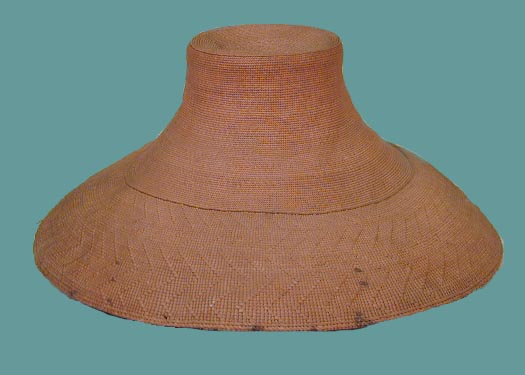
|
TWINED
SPRUCE ROOT HAT
Haida-style
weaving
The vertical zigag pattern on the brim of this hat is
called
"snail's tracks." The "jogs" on
this hat are very subtle, with no abrupt jumps betweenrows,
making it likely that this was woven by a very
experienced and careful weaver.
|
|
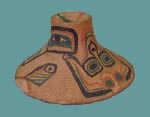
|
TWINED
SPRUCE ROOT HAT Haida-style weaving;
Kwakwaka'wakw-style painting
Sue
Devine, a former graduate student at the University
of
Washington, conducted research on Northwest Coast hats
twenty years ago. She wrote that some hats attributed
to
Haida weavers may have been woven on Vancouver Island
by Kwakwaka'wakw women, inspired by Haida models. If
so, it may be difficult to confirm this.
|
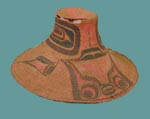 |
TWINED
SPRUCE ROOT HAT Haida-style weaving;
Kwakwaka'wakw-style painting
A standard design on painted hats is an abstract animal
with a
snout on the brim, eyes on the crown, and a tail opposite
the
snout. Fins or wings are located on the brim between
the
snout and tail.
|
|
|
|
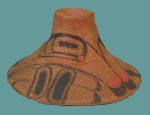 |
TWINED
SPRUCE ROOT HAT
Haida-style weaving and painting, collected
from the Tlingit
Though collected from the Tlingit,
this hat
shows a jog up to the right where the weaver
changes pattern, a Haida weaver's
characteristic. Tlingit weavers held their
baskets in the opposite direction, so their
hats have a jog down to the right.
|
|
| |
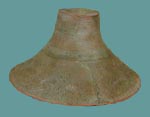 |
TWINED
SPRUCE ROOT HAT
Haida-style weaving; collected from the Tlingit
Greenish-blue paint was often applied to hats. Underneath
the green paint are traces of a design that used black,
yellow,
and red. Whether it was painted over for aesthetic or
water-proofing purposes in unknown.
|
|
| |
|
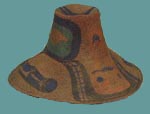
|
TWINED
SPRUCE ROOT HAT Haida-style weaving;
Kwakwaka'wakw-style painting
Like many hats, this one has black fabric ties stitched
to the
headband underneath to hold the hat on the head. The
edge
of this hat is finished in the same technique that Isabella
Edenshaw often useda four-strand, two-ridge flat braid.
However, the raised row above the braid is unlike her
style,
and no other details in this hat match the techniques
used by
Edenshaw.
|
|
| |
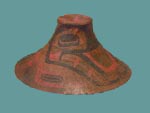 |
TWINED
SPRUCE ROOT HAT
Haida-style weaving and painting; collected
from the Tlingit
The concentric diamond pattern on this
hat
and on No. 6 is called mamatsiki,
"dragonfly." The painting on this hat shows
the Haida formline style with connected
bands of red and black, unlike the
Kwakwaka'wakw style that has
disconnected design elements.
|
|
| |
|
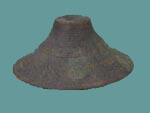
|
TWINED
SPRUCE ROOT HAT Haida-style weaving;
painted blue-green
It appears that this hat was painted blue-green only,
while
No. 3 had a pattern painted on it, and was then painted
over. Many Haida-style hats in museum collections have
this finish, which may have been applied as rainproofing.
|
|
| |
|
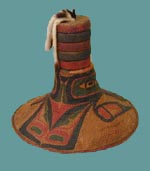
|
TWINED
SPRUCE ROOT HAT Haida-style weaving;
Kwakwaka'wakw-style painting; rings from a different
hat
This hat has been altered from its original form. It
appears
that parts of two separate hats have been joined together,
the basketry rings and the crown of the hat (at the
top) have
been joined to the flaring sides.
|
|
| |
|
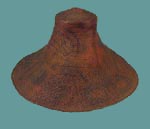
|
TWINED
SPRUCE ROOT HAT
Haida-style weaving, collected from the
Tlingit at Fort Tongass, 1899
Although, the brim on this hat has the
mamatsiki diamond design much like that
on the Isabella Edenshaw hat, these are not attributed
to
her. The raised row of S-twining between
the crown and brim, along with the complex
braid at the hat's edge, are not indicative of
Edenshaw's style.
|
|
|
 |
| |
 |
|
_________________________________________________________________________________________________
All material ©Burke Museum of Natural
History and Culture, 2001
theburke@u.washington.edu
|
|
|